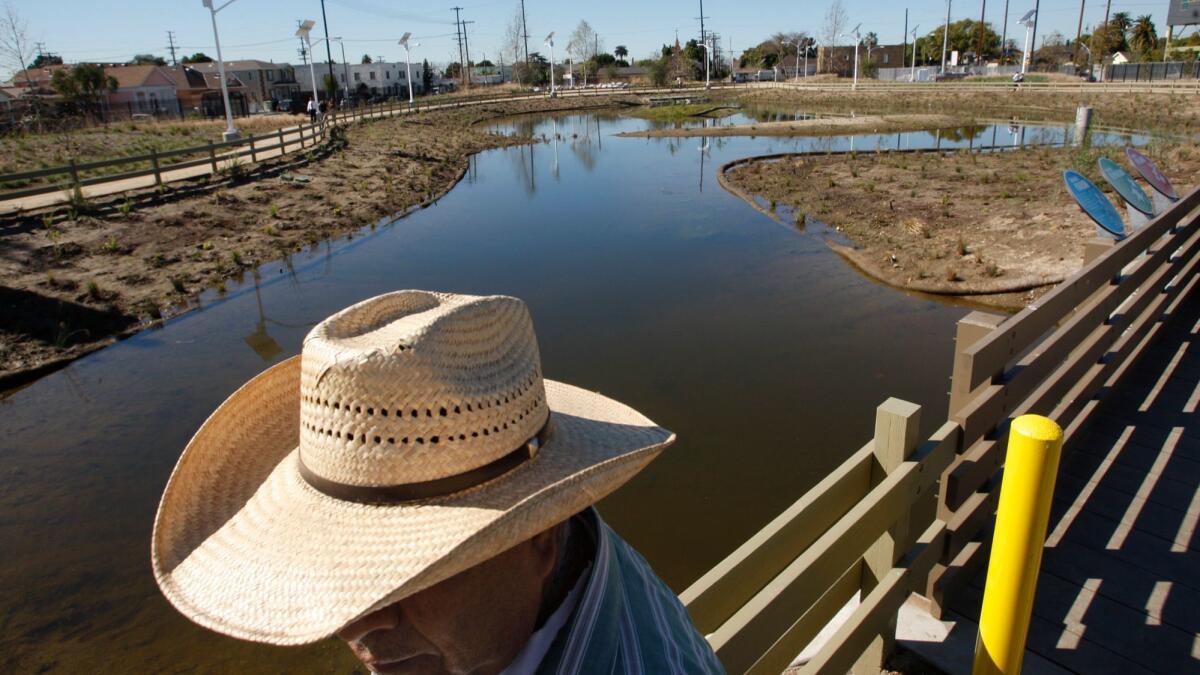Neighborhood Spotlight: South Park’s fortunes going in a westerly direction

When Angelenos hear the words “South Park,” the boundary-pushing animated series probably comes first to mind for most, whereas some real estate insiders will point to the new, booming neighborhood of gleaming residential towers rising east of the Staples Center.
In actuality, South Park is a neighborhood in southeast Los Angeles between the Harbor Freeway and Central Avenue. Overwhelmingly residential, South Park is an expanse of modest Craftsman homes surrounding the park from which it takes its name.
This stretch of the city was originally home to the citrus groves and vegetable gardens of immigrants from Japan and China. As the city outgrew its original boundaries and began to spread out in an orderly north-south grid pattern, trolley lines began to ply the broad new boulevards and avenues, serving the new suburban tracts south of downtown.
In the midst of one of those new tracts, the city purchased a rectangle of undeveloped land between Avalon Boulevard and San Pedro Street to create a municipal park. Tapping into an artesian well that provided plentiful irrigation water, the landscapers laid out a lush, semitropical paradise of flower beds and palm trees.
They dubbed it South Park, as it was at that time L.A.’s southernmost park, joining Westlake and Eastlake parks in a nomenclature scheme that bracketed the urban core with parks named after every cardinal point of the compass but the north. Upon its opening in 1899, it was an instant hit with Angelenos, a cool, verdant oasis convenient to a number of Los Angeles Railway trolley lines.
In 1903, developers built the notorious Ascot Park horse-racing track on the southern border of the neighborhood. Not unlike nearby Exposition Park, Ascot became as much known for the plenitude of illicit activities that were engaged in there as for its horse racing. With the advent of the automobile, it was converted to a motor speedway and was demolished in the early 1930s.
Restricted from living in most other parts of the city, black Angelenos began to move into the area in the 1920s, when nearby Central Avenue with its famous jazz clubs and thriving black-owned businesses became a nationally known center of black culture.
In more recent years, the demographics of the neighborhood have changed dramatically, with South Park becoming an important residential center for Latino immigrants.

Neighborhood highlights
Parks and rec: In park-starved L.A., South Park has the original 1899 green space and the relatively new South Los Angeles Wetlands Park, which opened in 2012.
Central location: Close to downtown, USC and Exposition Park, and convenient to the Blue and Expo Lines, South Park is in the heart of the revitalizing central city.
Craftsman deals: With much of the neighborhood’s inventory of Craftsman homes intact, South Park is a great place to buy a classic home for far less than you would pay elsewhere in the city.
Neighborhood challenge
Crime worries: Although South Park’s crime rate has decreased during the last 20 years, the community still ranks high for the occurrence of violent crime.
Expert insight
Ian Hollinger, a broker at BRC Advisors, has been operating in the South Park area for seven years and said downtown’s gentrification is beginning to trickle down into the community.
“South Park consists of hard-working people that, for the most part, are low-income with big families,” Hollinger said. “As more money gets pumped into the surrounding areas, landlords and tenants are hoping the community feels the effects in a positive way.”
Hollinger said the west side of South Park, which is closer to USC, benefits from new housing developments, whereas the east side, due to its lack of public transportation, tends to be neglected.
In the current housing market, he sees a good opportunity for young people to take on home projects that might turn others away.
“More people can afford to be in the game in this neighborhood,” Hollinger said. “You have to work that much harder to find a great deal, which might mean putting in a little extra sweat equity and getting your hands dirty.”
Market snapshot
South Park overlaps two Zip Codes. On the west side, 90037, the median sales price in August for single-family homes was $387,000 based on eight sales, according to CoreLogic. That’s a 10.6% increase in median sales price year over year.
On the east side, 90011, the median sales price was $353,000 based on 10 sales, a 24.4% increase year over year.
Report card
There are five public schools within the South Park boundaries. Aurora Elementary scored 762 in the 2013 Academic Performance Index, and Main Street Elementary scored 744.
Los Angeles Academy Middle and Forty-Ninth Street Elementary scored 708 and 676, respectively.
Times staff writer Jack Flemming contributed to this report.
MORE FROM HOT PROPERTY
Actress Denise Richards gives it another go in Hidden Hills
Glenn Frey’s scenic Brentwood estate lists for sale at $15 million
Late actress Glenne Headley’s 1920s Spanish home lists for $2.9 million
More to Read
Sign up for Essential California
The most important California stories and recommendations in your inbox every morning.
You may occasionally receive promotional content from the Los Angeles Times.






